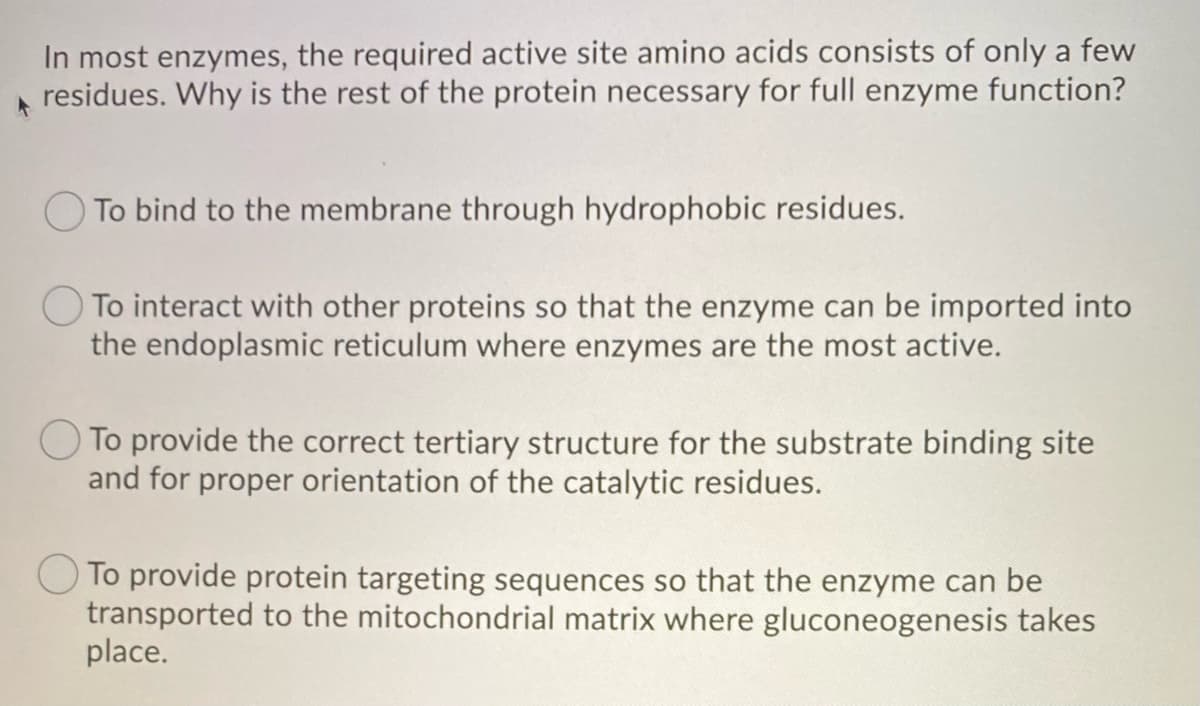In most enzymes, the required active site amino acids consists of only a few residues. Why is the rest of the protein necessary for full enzyme function? To bind to the membrane through hydrophobic residues. To interact with other proteins so that the enzyme can be imported into the endoplasmic reticulum where enzymes are the most active. To provide the correct tertiary structure for the substrate binding site and for proper orientation of the catalytic residues. To provide protein targeting sequences so that the enzyme can be transported to the mitochondrial matrix where gluconeogenesis takes place.
In most enzymes, the required active site amino acids consists of only a few residues. Why is the rest of the protein necessary for full enzyme function? To bind to the membrane through hydrophobic residues. To interact with other proteins so that the enzyme can be imported into the endoplasmic reticulum where enzymes are the most active. To provide the correct tertiary structure for the substrate binding site and for proper orientation of the catalytic residues. To provide protein targeting sequences so that the enzyme can be transported to the mitochondrial matrix where gluconeogenesis takes place.
Biology: The Dynamic Science (MindTap Course List)
4th Edition
ISBN:9781305389892
Author:Peter J. Russell, Paul E. Hertz, Beverly McMillan
Publisher:Peter J. Russell, Paul E. Hertz, Beverly McMillan
Chapter4: Cells
Section: Chapter Questions
Problem 1ITD
Related questions
Question

Transcribed Image Text:In most enzymes, the required active site amino acids consists of only a few
residues. Why is the rest of the protein necessary for full enzyme function?
To bind to the membrane through hydrophobic residues.
To interact with other proteins so that the enzyme can be imported into
the endoplasmic reticulum where enzymes are the most active.
To provide the correct tertiary structure for the substrate binding site
and for proper orientation of the catalytic residues.
To provide protein targeting sequences so that the enzyme can be
transported to the mitochondrial matrix where gluconeogenesis takes
place.
Expert Solution
This question has been solved!
Explore an expertly crafted, step-by-step solution for a thorough understanding of key concepts.
This is a popular solution!
Trending now
This is a popular solution!
Step by step
Solved in 2 steps

Recommended textbooks for you

Biology: The Dynamic Science (MindTap Course List)
Biology
ISBN:
9781305389892
Author:
Peter J. Russell, Paul E. Hertz, Beverly McMillan
Publisher:
Cengage Learning

Biology: The Dynamic Science (MindTap Course List)
Biology
ISBN:
9781305389892
Author:
Peter J. Russell, Paul E. Hertz, Beverly McMillan
Publisher:
Cengage Learning